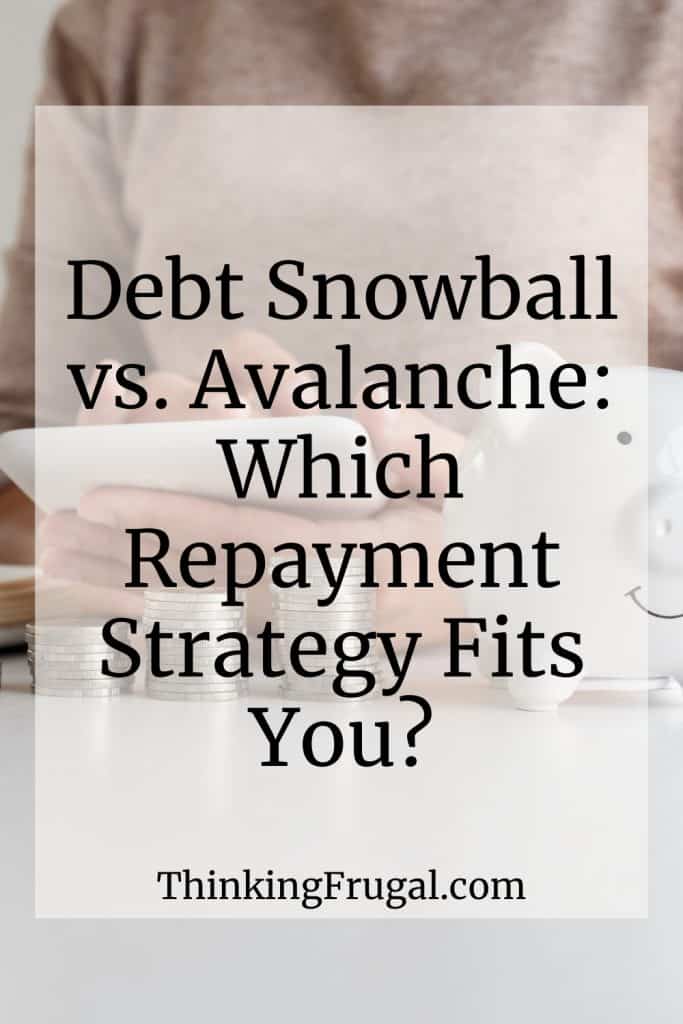Debt Snowball vs. Avalanche: Which Repayment Strategy Fits You?
I make money on some of the products and services I mention on Thinking Frugal through affiliate relationships. I never endorse a product or service unless I believe it will benefit my readers.
Managing and paying off debt can feel like an uphill battle, but it doesn’t have to be. Two popular strategies, the Debt Avalanche and Debt Snowball methods, offer clear paths to becoming debt-free.
Understanding the differences between these strategies and the pros and cons of each is crucial in deciding which approach aligns best with your financial goals and personal motivation.
This post will break down each technique, helping you decide which is best for your unique situation.
Make an Extra $100+ Per Month for Free:
Earnably: Earn gift cards or PayPal cash to watch videos, complete surveys, and more.
GrabPoints: Earn money watching videos, completing surveys, downloading apps, and more.
Ibotta: Get paid to shop.
InboxDollars: Get paid to watch videos, shop, complete surveys, and more.
InstaGC: Earn gift cards, or PayPal cash by watching videos, taking surveys, shopping, and more.
Swagbucks: Earn gift cards, or PayPal cash by watching videos, taking surveys, shopping, and more.

Understanding the Basics of Debt Management
Debt can be overwhelming, especially if you’re juggling multiple loans or credit card balances.
The key is to find a strategy that fits your situation and personality, and this is where the Debt Avalanche and Debt Snowball techniques come in.
Both aim to help you pay off debt efficiently but take different approaches.
What is the Debt Avalanche Method?
The Debt Avalanche system focuses on paying off debts with the highest interest rates first.
Here’s how it works:
- List all your debts.
- Order them from highest to lowest interest rate.
- Pay the minimum on all debts except the one with the highest interest rate.
- Pay any extra money toward the debt that has the highest interest rate.
- Once that debt is paid off, move to the next highest interest rate debt.
By tackling high-interest debts first, you save more on interest over time.
The Debt Avalanche method is perfect for those who want to minimize the amount they pay in interest.
The Benefits of the Debt Avalanche Method
The main advantage of the Debt Avalanche technique is the potential savings on interest. By paying off high-interest debts first, you’ll reduce the total interest you pay, saving you money in the long run.
Another benefit is that this method is mathematically efficient. It focuses on reducing the overall cost of your debt, making it a smart choice for those financially disciplined and motivated by long-term savings.
Finally, the Debt Avalanche technique can help you pay off debt faster. Eliminating high-interest debts frees up more money for other debts, speeding up the repayment process.
Drawbacks of the Debt Avalanche Method
Despite its benefits, the Debt Avalanche technique has some drawbacks. One challenge is that it requires patience and discipline. Because you focus on high-interest debts first, it might take longer to see progress, which can be discouraging.
Another drawback is that this method doesn’t offer quick wins. If you’re motivated by small victories, the Debt Avalanche method might not provide the immediate satisfaction you need to stay motivated.
Lastly, it requires a solid understanding of your debts and interest rates. If you’re not comfortable with numbers or have trouble organizing your debts, the Debt Avalanche method might be more challenging to implement.
What is the Debt Snowball Method?
The Debt Snowball method uses a different approach. It doesn’t focus on interest rates. Instead, it prioritizes paying off the smallest debts first.
Here’s how it works:
- List all your debts.
- Order them from smallest to largest balance.
- Pay the minimum on all debts except the smallest one.
- Pay any extra money towards the debt with the smallest balance.
- Once that debt is paid in full, move to the next smallest debt.
The idea is to build momentum by achieving small victories early on.
The Debt Snowball technique is ideal for anyone who needs motivation and a sense of accomplishment to stay on track.
The Benefits of the Debt Snowball Method
The main advantage of the Debt Snowball technique is the psychological boost it provides. By paying off small debts first, you achieve quick wins, which can keep you motivated and focused.
Another benefit is its simplicity. It doesn’t require a deep understanding of interest rates or complicated calculations. You simply focus on the smallest debt, making it easier to manage and follow.
Finally, the Debt Snowball method can help build good financial habits. By consistently paying off debts, you develop a routine of managing your money, which can lead to better financial practices in the long run.
Drawbacks of the Debt Snowball Method
While the Debt Snowball method offers motivational benefits, it also has some drawbacks. One challenge is that it might cost you more in interest over time. By focusing on small debts instead of high-interest debts, you could end up paying more in interest.
Another drawback is that it might take longer to become debt-free. Since you’re not prioritizing high-interest debts, it could take more time to pay off all your debts, especially if you have large high-interest loans.
Lastly, the Debt Snowball method might not be as financially efficient. If you’re motivated by numbers and long-term savings, the Debt Avalanche technique might be a better fit for you.
Comparing the Debt Avalanche and Debt Snowball Methods
Both of these approaches have pros and cons, and the best choice depends on your personality and financial situation.
Here are some factors to consider when deciding which method to use:
- Motivation: If you need quick wins to stay motivated, the Debt Snowball method might be better for you. The Debt Avalanche technique could be a better fit if you’re motivated by long-term savings.
- Interest Rates: If you have high-interest debts, the Debt Avalanche method will ultimately save you more money. If your debts have similar interest rates, the Debt Snowball method might be more effective.
- Financial Discipline: If you’re disciplined and can stick to a plan, the Debt Avalanche method might be a good choice. If you struggle with motivation and need regular achievements, the Debt Snowball method could be a better option.
Real-Life Example of the Debt Avalanche Method
Imagine you have three debts:
- Credit card debt of $5,000 at 20% interest
- Student loan of $10,000 at 6% interest
- Car loan of $7,000 at 9% interest
If you’re using the Debt Avalanche method, you will focus on the credit card debt first because it has the highest interest rate.
You pay the minimum on the other debts and put any extra money towards the credit card.
Once it’s paid off, you move to the car loan and, finally, the student loan.
Real-Life Example of the Debt Snowball Method
Now, imagine the same debts:
- Credit card debt of $5,000 at 20% interest
- Student loan of $10,000 at 6% interest
- Car loan of $7,000 at 9% interest
If you’re using the Debt Snowball technique, you will pay the credit card debt first because it has the smallest balance.
You pay the minimum on the other debts and put any extra money towards the credit card.
Once it’s paid off, you move to the car loan and, finally, the student loan.
Tips for Successfully Managing Debt
Regardless of which one you choose, here are some tips to help you successfully manage your debt:
- Create a Budget: Having a budget will help you track your income and expenses, making it easier to allocate money towards debt repayment.
- Cut Unnecessary Expenses: Look for areas where you can reduce spending and use that money to pay off your debts faster.
- Increase Your Income: Consider a side job or freelance work to make extra money that you can put towards your debts.
- Stay Disciplined: Stick to your chosen method and focus on your goal of becoming debt-free.
- Celebrate Milestones: Reward yourself for achieving milestones along the way to stay motivated and on track.
The Importance of Understanding Your Financial Situation
Before choosing a debt repayment method, it’s important to understand your financial circumstances.
Take the time to list all your debts, interest rates, and balances. Making a list will help you make an informed decision about which technique is best for you.
Seeking Professional Financial Advice
If you’re unsure about which method to choose or need help managing your debt, consider seeking professional financial advice.
A financial advisor can offer personalized advice and help you create a debt repayment plan that fits your needs.
Taking Control of Your Financial Future
Ultimately, the goal of both the Debt Avalanche and Debt Snowball methods is to help you take control of your financial future.
By actively managing your debt and making consistent payments, you can work on becoming debt-free and achieving financial stability.
Final Thoughts
Both the Debt Avalanche and Debt Snowball techniques offer effective strategies for managing debt. The best choice depends on your individual needs, financial situation, and motivation.
By understanding the benefits and drawbacks of each, you can make an informed decision and take the first step towards a debt-free future.
Remember, the key to your success is consistency and discipline. Stick to your chosen method, stay focused on your financial goals, and celebrate your progress.
With the right strategy and mindset, you can achieve financial freedom and take control of your financial future.







